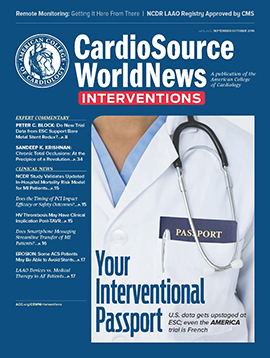Interview: A Polymer-free Drug-Filled Stent The RevElution Trial
CardioSource WorldNews Interventions | A number of new stents have become available to cardiologists over the last few years. At ACC.16, CardioSource WorldNews: Interventions caught up with Stephen Worthley, MD, FACC, professor, chair of cardiovascular medicine, and director of the cardiac catheterization laboratory at the University of Adelaide in Australia, about the next generation of stent evaluated in the RevElution Study.
CSWN Interventions: Describe for us the RevElution study and the stent.
Stephen Worthley, MD: The RevElution study looks to be a revolution in interventional cardiology. The reason behind the name is the “elution” part of it, which is unique. So we know that drug-eluting stents (DES), which have become the mainstay of a treatment of patients with coronary artery disease, have a mechanism for delivering antiproliferative drug to the vessel to stop a re-narrowing—restenosis—by embedding these antiproliferative drugs in polymers.
Polymers are effectively a plastic coat that is around the stent. When the drug has eluted and gone away, generally speaking, the polymer stays behind. These plastics actually induce an inflammation, they’re an irritant, if you like, to the vessel wall; this actually impedes the natural healing, a growing of skin—endothelium—over the stent. These polymers that have led to the issue around stents not healing as quickly and, therefore, getting clots on them or stent thrombosis.
This new stent, which we evaluated in the trial, delivers the drug and elutes the drug with the same sort of kinetics over the same time period as a current DES, but does not have a polymer at all. In this unique way, we’ve been able to core out, if you like, the internal part of the stent so that the stent itself is not any thicker. In fact, if anything, it’s thinner than a number of the current stents we use. We core out the inner part of it and put the drug inside the stent to act as a reservoir. We then drill tiny 20 micron diameter micro holes on the outer surface, the abluminal surface of the stent so that the drug just slowly elutes onto the vessel wall. And, therefore, allow for the efficacy so that you don’t see any re-narrowing—there’s now no polymer to induce an inflammatory response.
What else can you tell us about the study design and patients?
So at the moment, the RevElution Study has enrolled 75 patients. It’s a single arm observational first-in-human trial and multi-center. It includes centers mainly in Australia, but also in Singapore and Brazil.
It is slightly complicated design in that we’ve embedded a number of imaging time points in some of the patients so that we can gain some insights from optical coherence tomography (OCT)—a very high-resolution intravascular imaging technique—at early time points to see if that premise of early healing is in fact seen in the imaging.
And, indeed, through the complete dataset of all of the patients that have had 1 month OCT imaging, we saw what we thought we would see—early healing.
We had 15 patients in that study. We saw healing in effectively 90% of the struts. At 1 month, we already saw an endothelial coat or covering over the stent struts. And yet, we saw, apart from that healing, very minimal intrusion into the vessel by that healing process, so it was over proliferative. In fact, the actual healing on average was a 60-micron neointima inside the vessel.
OCT has sometimes delivered surprising images of the bioabsorbable stents—it was a very big surprise and researchers weren’t really predicting it. In this case, you’re seeing exactly what you wanted to see.
It’s what we hoped to see, exactly right. You never know until you do the trial, but it basically what we’d seen in that early preclinical work that indeed, we’d seen an early healing at 1 month. We’ve seen very low neointimal proliferation. We’ve seen very little malapposition, meaning where the stent itself is now is not adherent to the vessel wall. So it’s a malapposed strut—1.5%, which is actually very low because, in normal clinical practice, we’d expect somewhere between a 3% to 7% malapposed struts.
It’s 1-month data, but it’s the complete 1-month dataset on the OCT sub-study and it’s very exciting.

|
Read the full September/October issue of CardioSource WorldNews Interventions at ACC.org/CSWNI |
Keywords: CardioSource WorldNews Interventions, Cardiac Catheterization, Cardiovascular Agents, Coronary Artery Disease, Drug-Eluting Stents, Polymers, Stents
< Back to Listings
